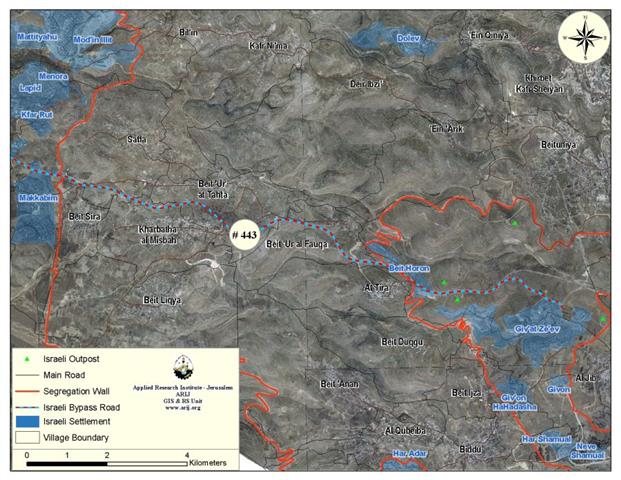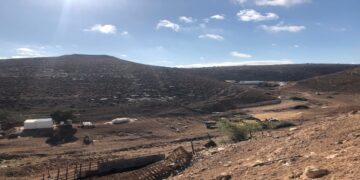''Everyone lawfully within the territory of a State shall, within that territory,
have the right to liberty of movement and freedom to choose his residence.'
Israeli Bypass roads
It has been a policy of the Israeli occupation to link the 199 Israeli settlements in the West Bank with one another and with the Israeli network of road system to serve the Israeli settlers and to facilitate their movement toward one another and beyond the 1949 Armistice Line (the Green Line). During the past four decades of the Israeli occupation, the Israeli Government managed to construct 792 kilometers of bypass roads throughout the occupied West Bank territory.
The network of Israeli bypass roads started to shape since the year 2000, with the beginning of the second Intifada, as the Israeli authorities enforced restrictions on the freedom of movement of Palestinians in the West Bank by constructing road blocks, gates and checkpoints and hindered their access through the Israeli bypass roads contrary to what was agreed on at Oslo accords that the Palestinians shall have the full right to travel on the bypass roads that were constructed on private Palestinian lands.
What is Road 443?
Road 443 extends for 17 kilometers and links the northwestern parts of Jerusalem with Tel Aviv metropolitan area. The road also functions as a main highway between Ramallah Governorate and several Palestinian villages located to the southwest of the Governorate such as Al Burj, Saffa, Kharbatha El Misbah, Beit 'Ur El Tahta, Beit 'Ur El Fuqa and Beituniya. Prior to the year 2000, the Israeli Army started to develop the road by increasing its width to become a four- lane highway on the expanse of the Palestinian private lands, during which, dozens and hundreds of Olive trees were uprooted to carryout the plan, and according to the Israelis, the road was to serve the Palestinians as well as the Israeli's in order to meet their needs. See Map 1
However, in 2002, the Israeli Army prohibited local Palestinian villagers from traveling on the road by car or by foot justifying their decision for �security purposes,� hence the road, which is built on the Palestinians� land became off limit for them and was designated only to Israeli settlers. This violent step forced the Palestinian villagers to look for alternative roads in an attempt to reach Ramallah city. It is worth pointing out that the prohibition was never authorized by any military order but it was by constructing roadblocks, checkpoints, watchtowers, iron gates, and Israeli patrols.
The prohibition has negatively affected the Palestinian lives as the closure hindered their access to their work places, schools, universities and medical services in Ramallah city where the main services providers are located. from that point on, the travel to Ramallah became long journey, and instead of their regular and traditional 10 minutes drive on road 443, it takes them 10 time the time and more than that during the winter time when the roads are muddy and more dangerous to drive on, where the Palestinians are forced to travel through the villages of Bil'in, Kafr Ni'ma, Deirr Ibzi', 'Ein 'Arik and Betuniya.
Petition to the Israeli High Court of Justice
In July 2007, the Palestinian residents of the affected villages petitioned to the High Court of Justice to remove the obstructions that prevent them from accessing the road, and to reopen it to the Palestinian travel. As a response, the Israeli Army announced that they would allow the access to commercial and public service vehicles on the road but only during the daytime and that travel by night is only for humanitarian needs. The villagers did not accept this decision, as many of them need to reach their work places, agricultural lands, hospitals and visit their relatives who live in the nearby villages.
The Israeli restriction of Palestinians' movement within their territory affects their basic human rights; such as the right to work, the right to health, the right to an adequate standard of living, the right to protection of family life and the right to education, all set in the International Covenant on Economic, Social and Cultural Rights. Article 13 of the Universal Declaration of Human Rights and Article 12 of the International Covenant on Civil and Political Rights also entail the right to move freely from one place to another within the state.
Article 13: 'Everyone has the right to freedom of movement and residence within the borders of each State and everyone has the right to leave any country, including his own, and to return to his country.'
Article 12: 'Everyone lawfully within the territory of a State shall, within that territory, have the right to liberty of movement and freedom to choose his residence and no one shall be arbitrarily deprived of the right to enter his own country.'
Prepared by
The Applied Reserach Institute – Jerusalem














